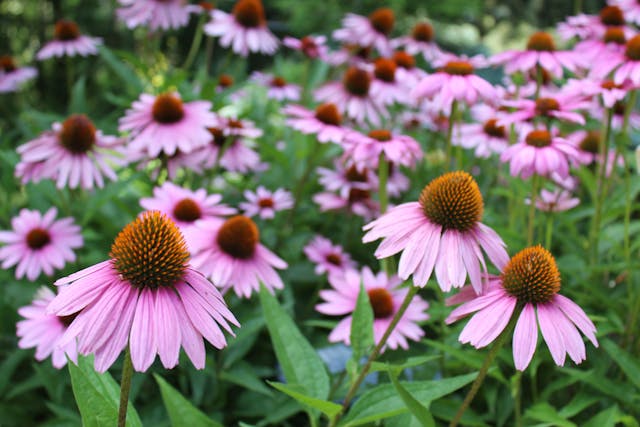Purple & White Coneflowers Are Not Toxic to Dogs or Cats
You can breath a sigh of relief if you spy your dog or cat chewing on some and wonder “why is my dog eating my coneflowers?” It may be out of curiousity or to settle its tummy, but at least it is pet safe so you in little nibbles, it is not cause for concern. We check the flowers we feature on our site with the ASPCA and do extensive internet research for both the common and scientific name just to be super pet safe.
So you know, we check the flowers we feature on our site with the ASPCA and do extensive internet research for both the common and scientific name just to be super pet safe. If we cannot find direct reference, we check up to genus and so on until we can confirm whether a plant is toxic or non toxic to both cats and dogs. If we are not sure, or get contradictory information, we do not include it. Many of the plants featured we have grown successfully in our own pet safe garden in Northern California. You can see many of garden stars in photos from Lovie’s Pet Safe Garden.

Physical Attributes
Coneflowers have daisy-like flowers with raised conical centers and drooping ray petals in shades of purple, pink, yellow, orange, red, white, and green. They grow 2-5 feet tall with coarse, hairy leaves. The most familiar is the purple coneflower (Echinacea purpurea).
General Care Tips and Pointers
Plant in full sun to partial shade. Provide well-drained soil and about 1 inch of water weekly. Deadhead spent blooms to prolong flowering. Divide clumps every 4 years when crowded. Coneflowers are heat and drought tolerant once established.
Fun Facts/Trivia
All Echinacea species are native to the U.S., found across the Midwest and South. Their spiny centers and strong aroma make them deer resistant, though not completely deer-proof. Coneflowers attract bees, butterflies, and songbirds to the garden. The purple coneflower (E. purpurea) is used in herbal remedies.
| Consideration | Details |
|---|---|
| Container Friendly | Yes, can be grown in containers.[1] |
| Indoor/Outdoor | Outdoor[1][2][3] |
| Sun/Shade | Full sun to partial shade[1][3] |
| Perennial/Annual | Perennial[1][2][3] |
| Flowering | Daisy-like flowers in purple, pink, yellow, orange, red, white from late spring to frost.[1][2][3] |
| Drought Tolerant | Yes, drought tolerant once established.[1][3] |
| Pollinator Magnet | Yes, attracts bees, butterflies and birds.[1][2][3] |
| Beginner Friendly | Yes, easy to grow.[1][3] |
| Good Ground Cover | No, grows 2-5 feet tall.[1] |
| Good Privacy Screen | No, not tall enough. |
| Invasive/Spreader | No, clumping but not invasive. Can reseed readily.[1][3] |
| Dog & Cat Durable | Unknown, but likely durable as non-toxic perennials. |
| Rodent Repellent | Spiny centers may deter some rodents.[1] |
| Deer Resistant | Somewhat deer resistant due to spiny centers and aroma, but not completely deer-proof.[1] |
| Native | Yes, all Echinacea species are native to the U.S.[1][2][3] |
Citations:
[1] https://www.gardendesign.com/flowers/coneflower.html
[2] https://www.whiteflowerfarm.com/echinacea-coneflower
[3] https://www.americanmeadows.com/content/perennials/echinacea/how-to-grow-echinacea
[4] https://www.prairiemoon.com/echinacea-pallida-pale-purple-coneflower
[5] https://www.prairieroadorganic.co/products/echinacea-purple-coneflower





